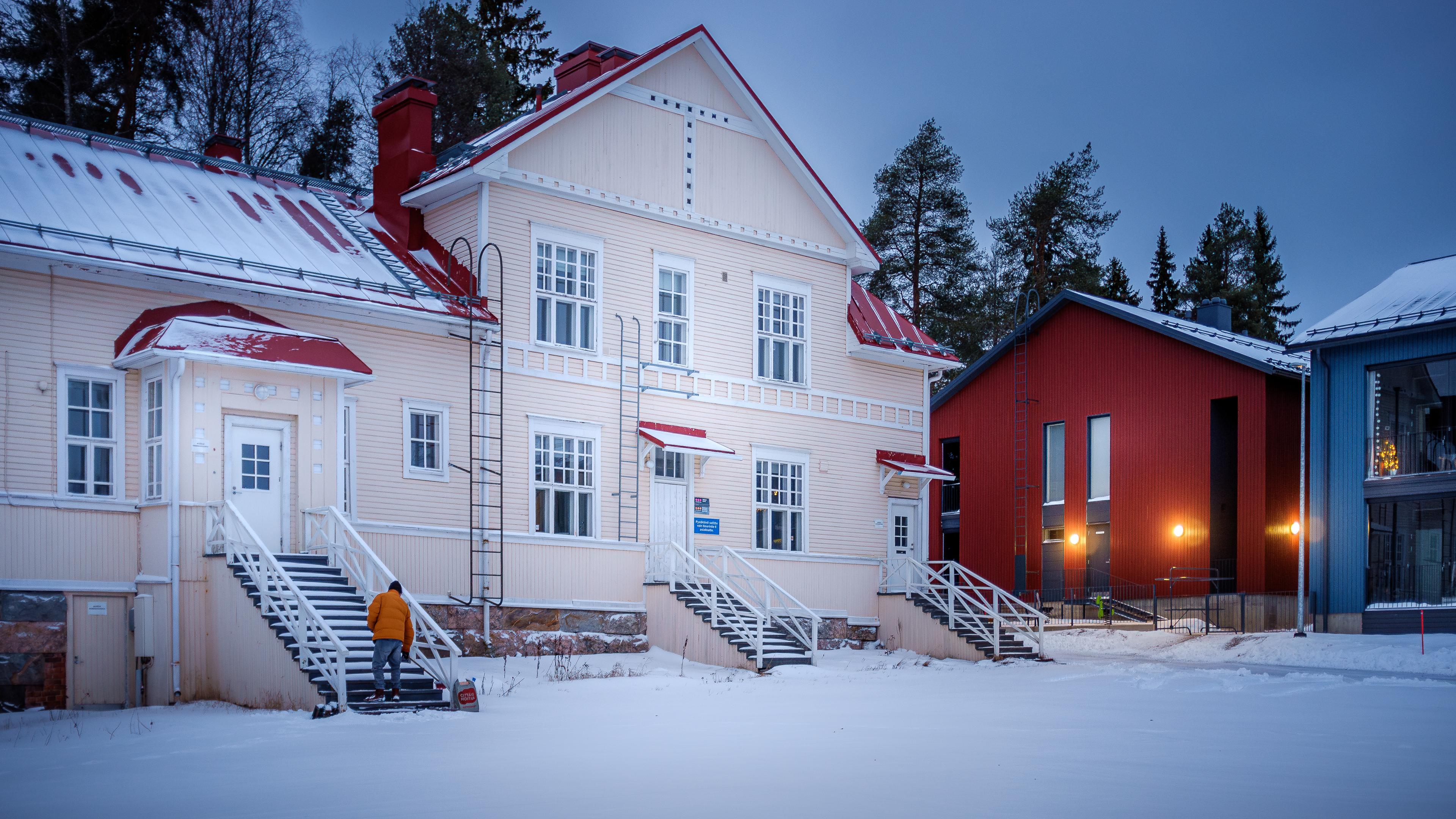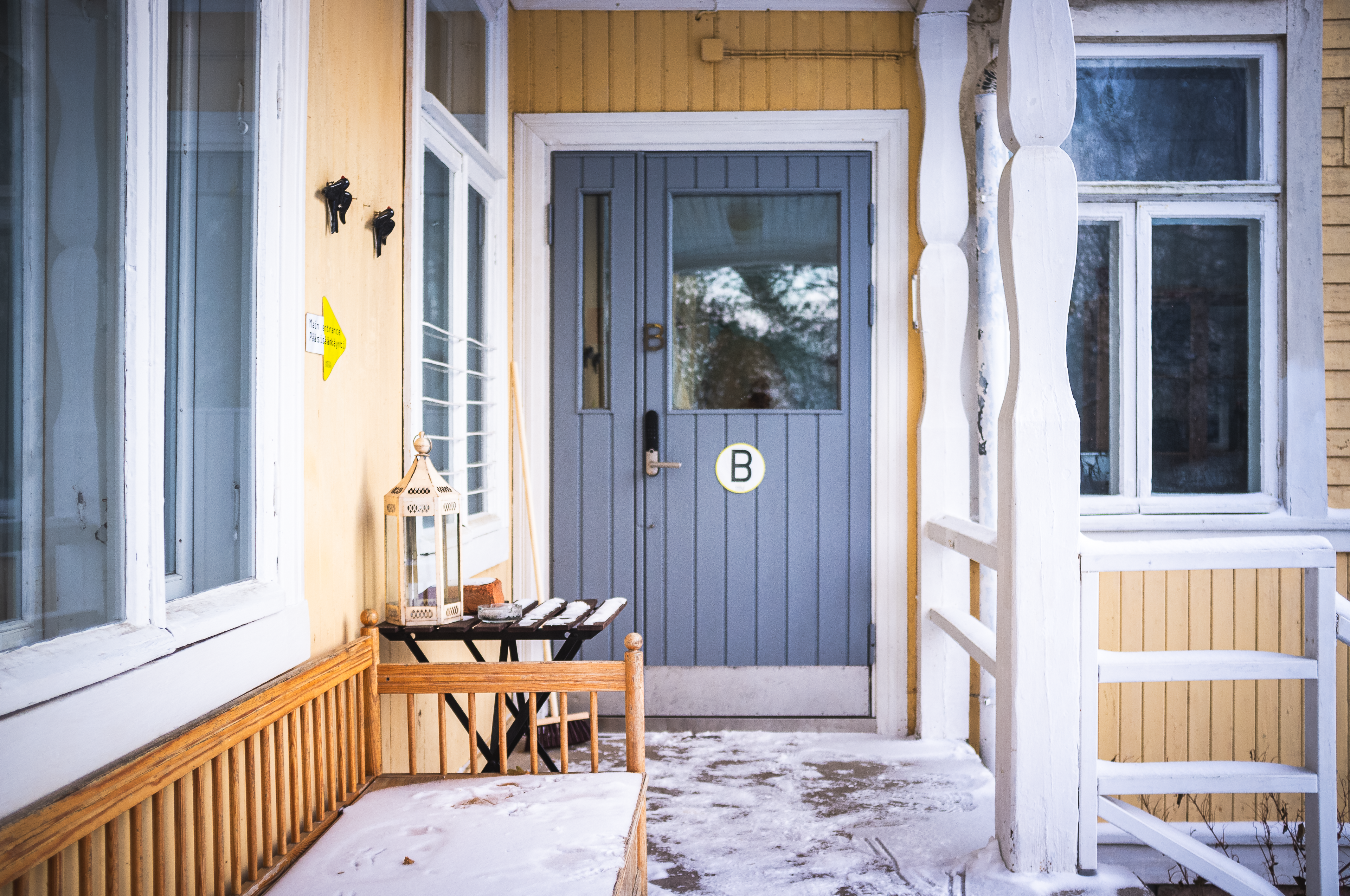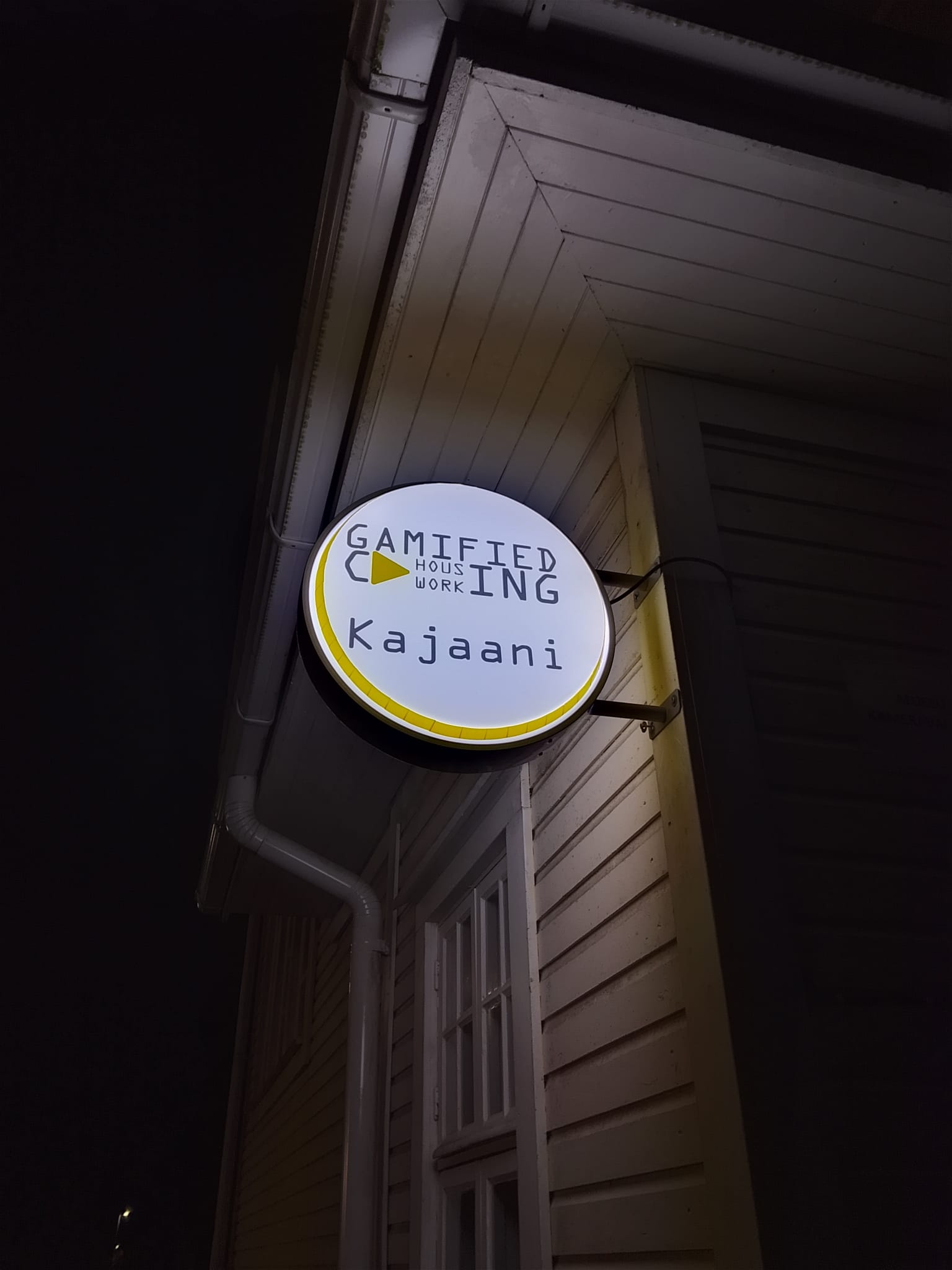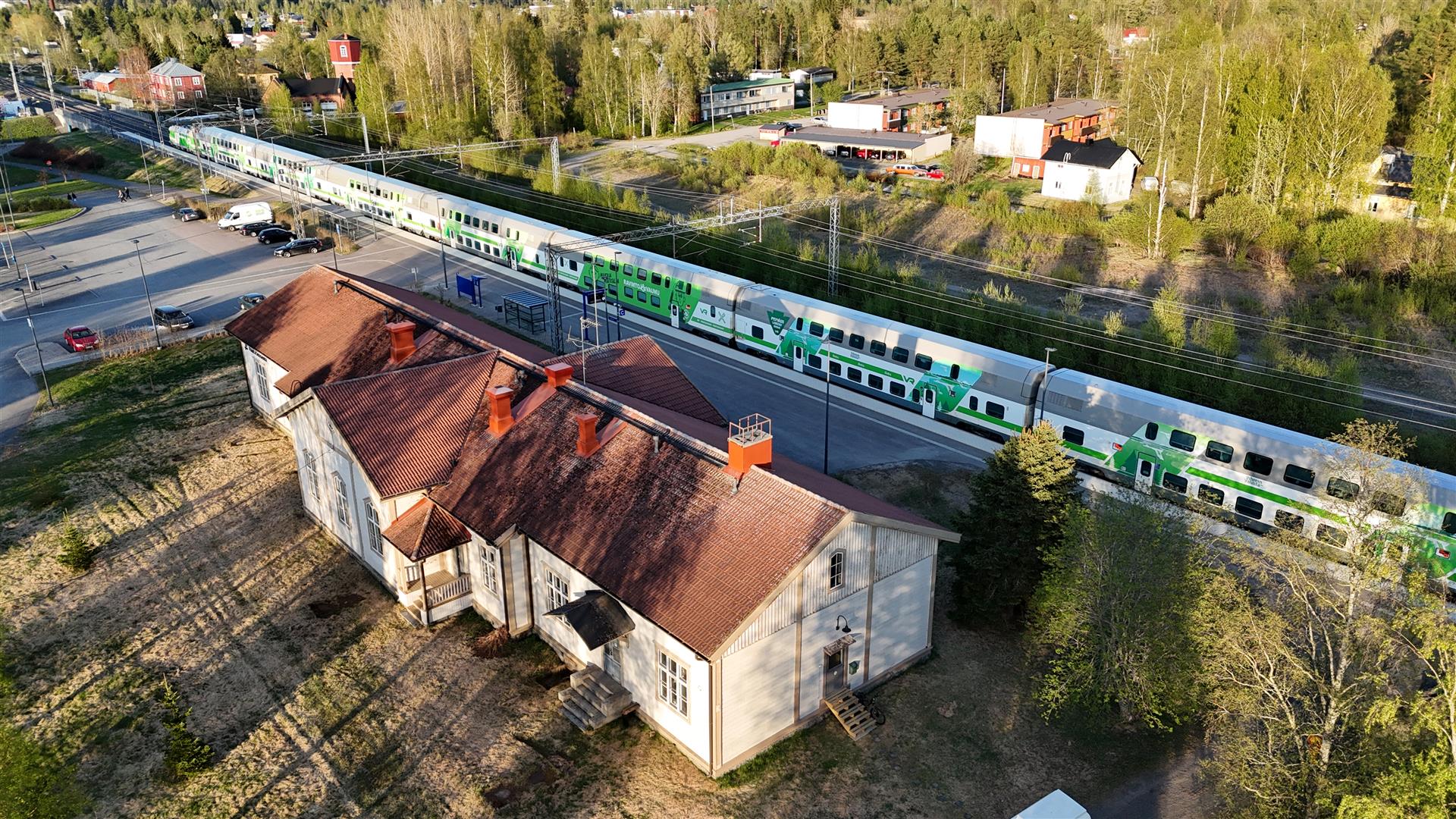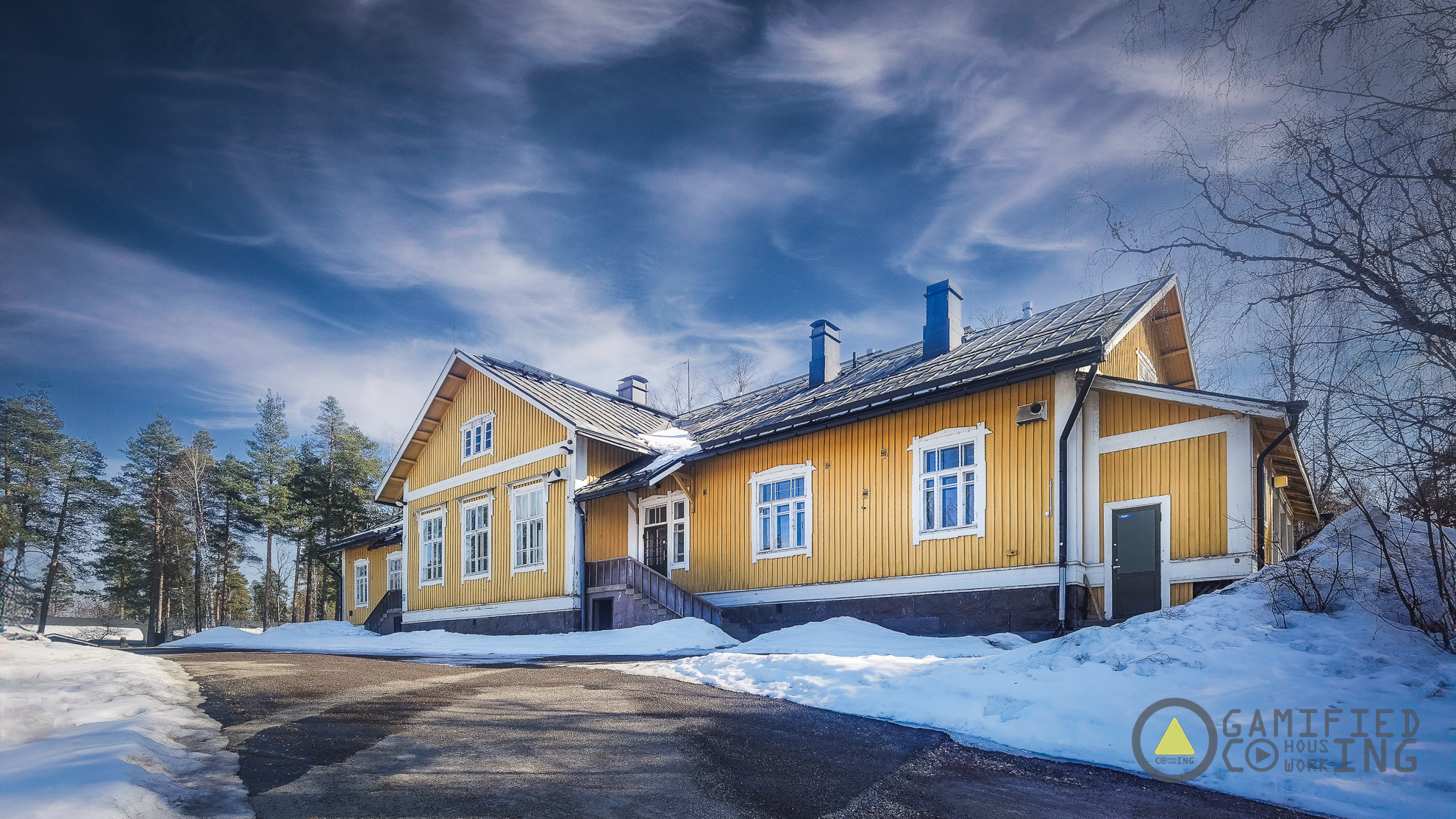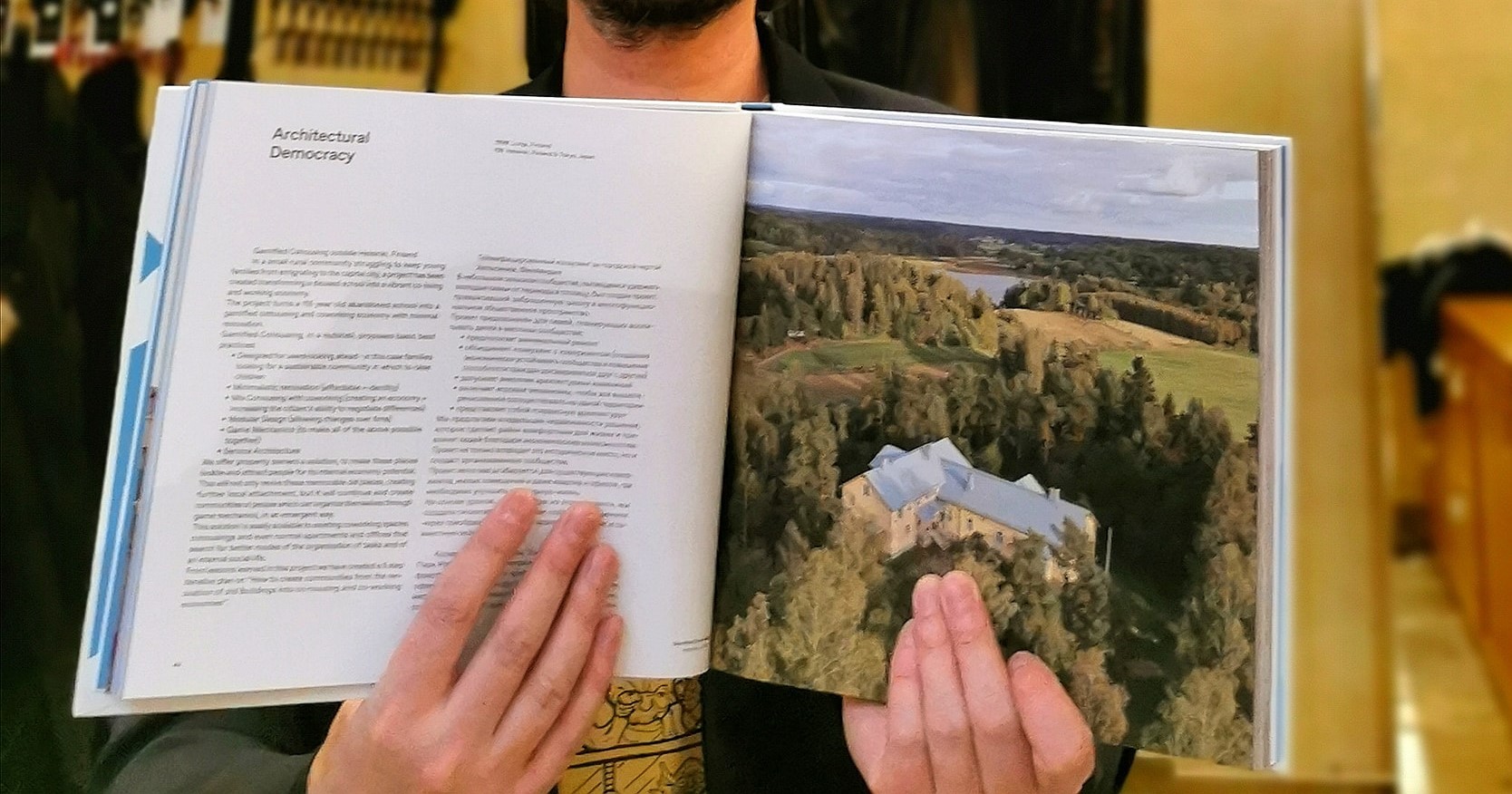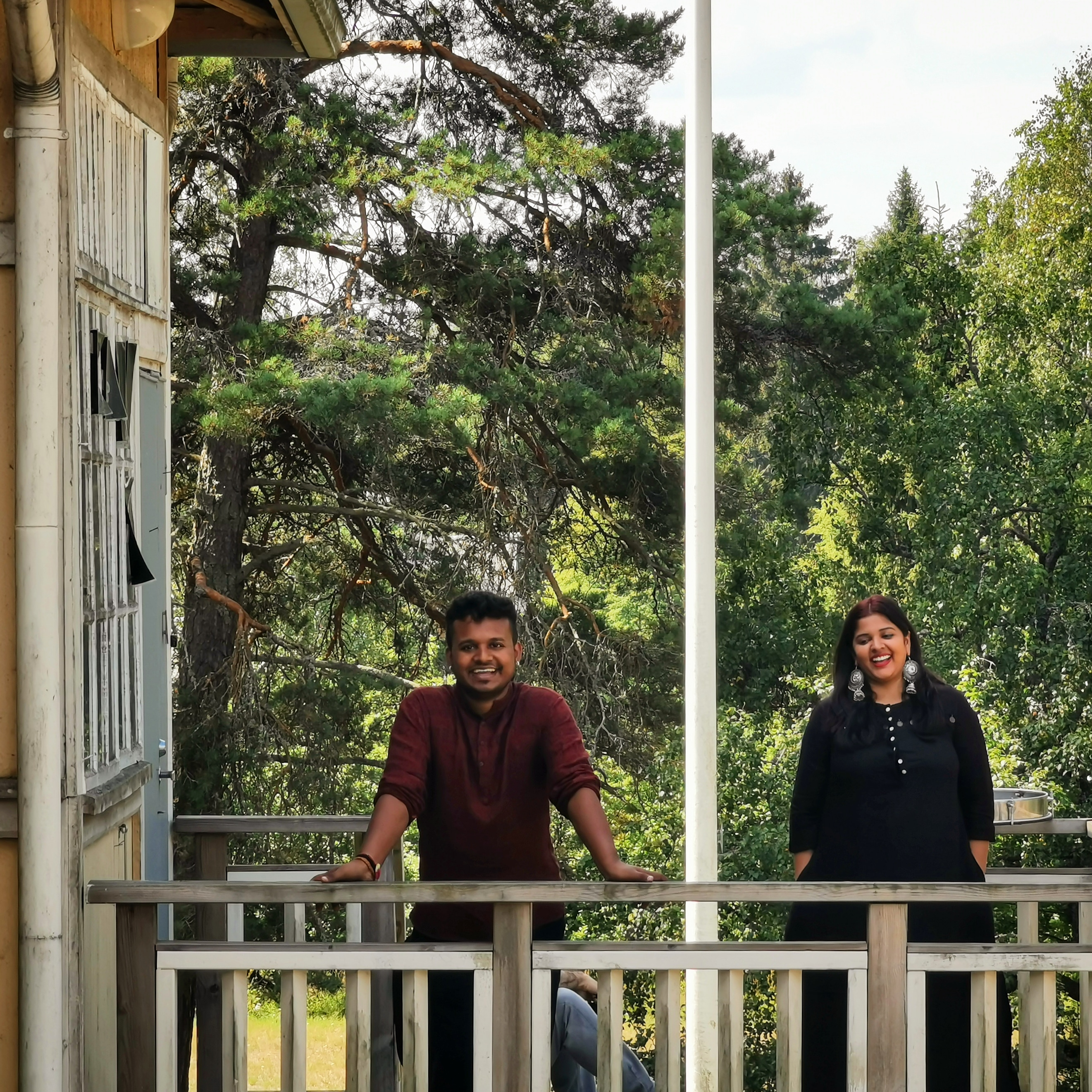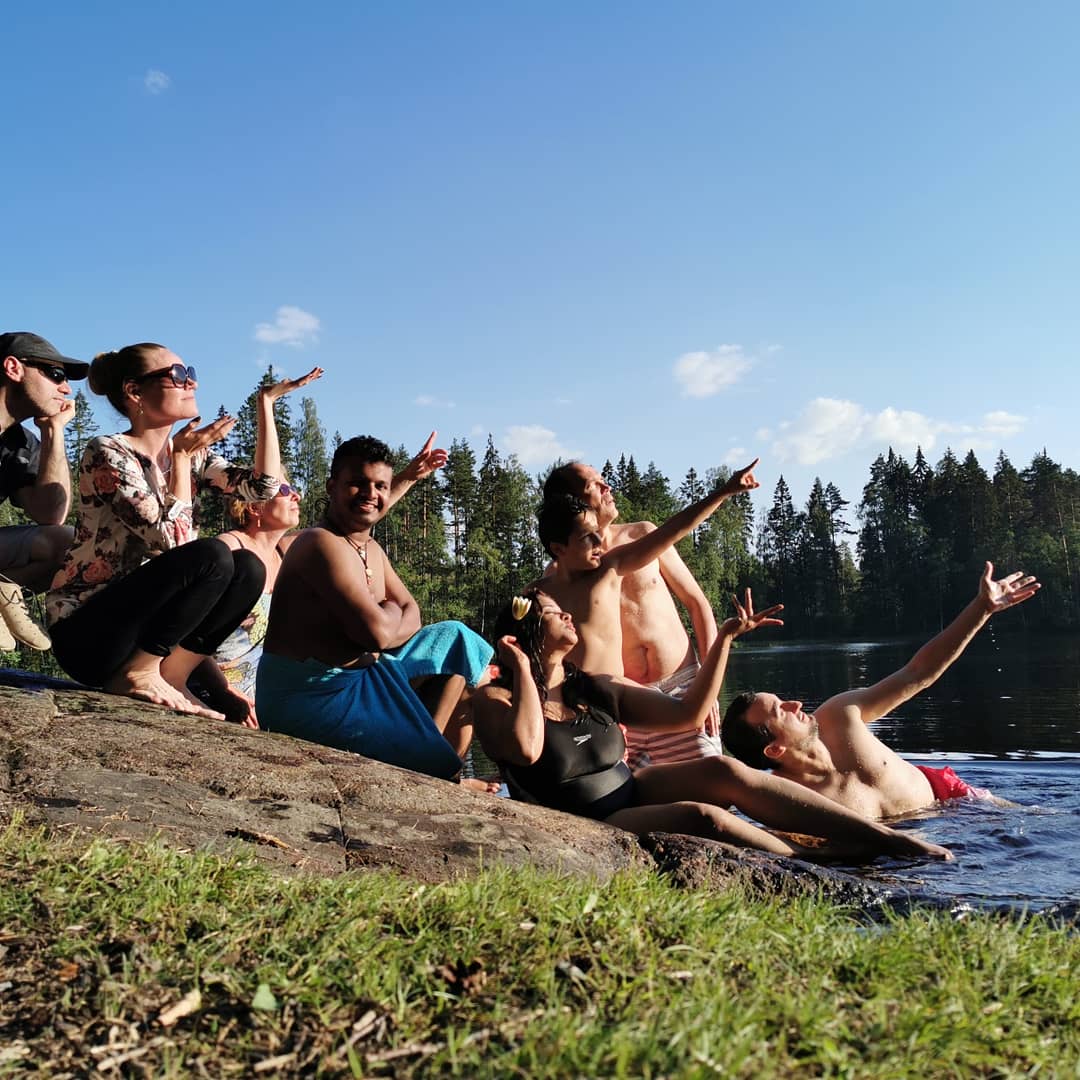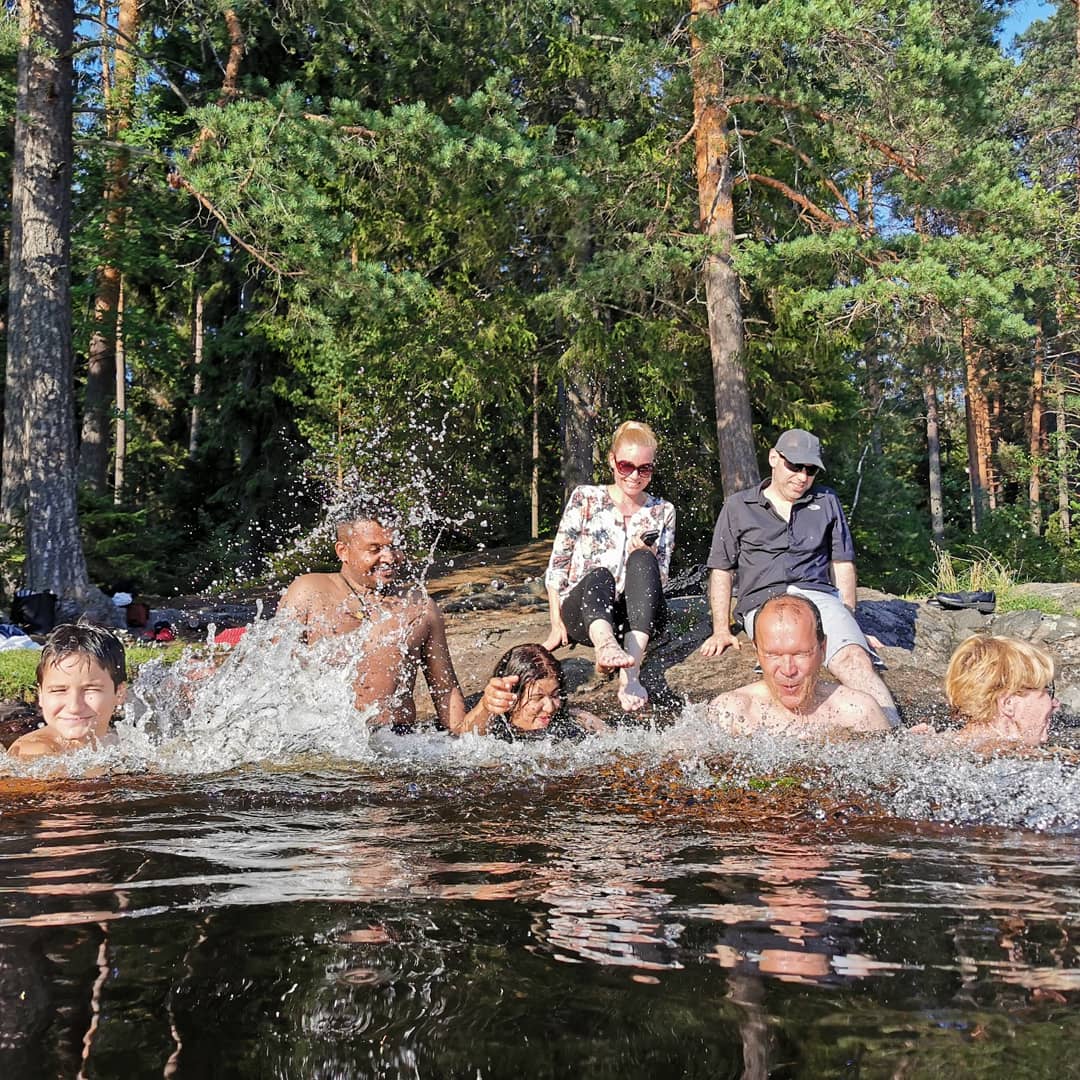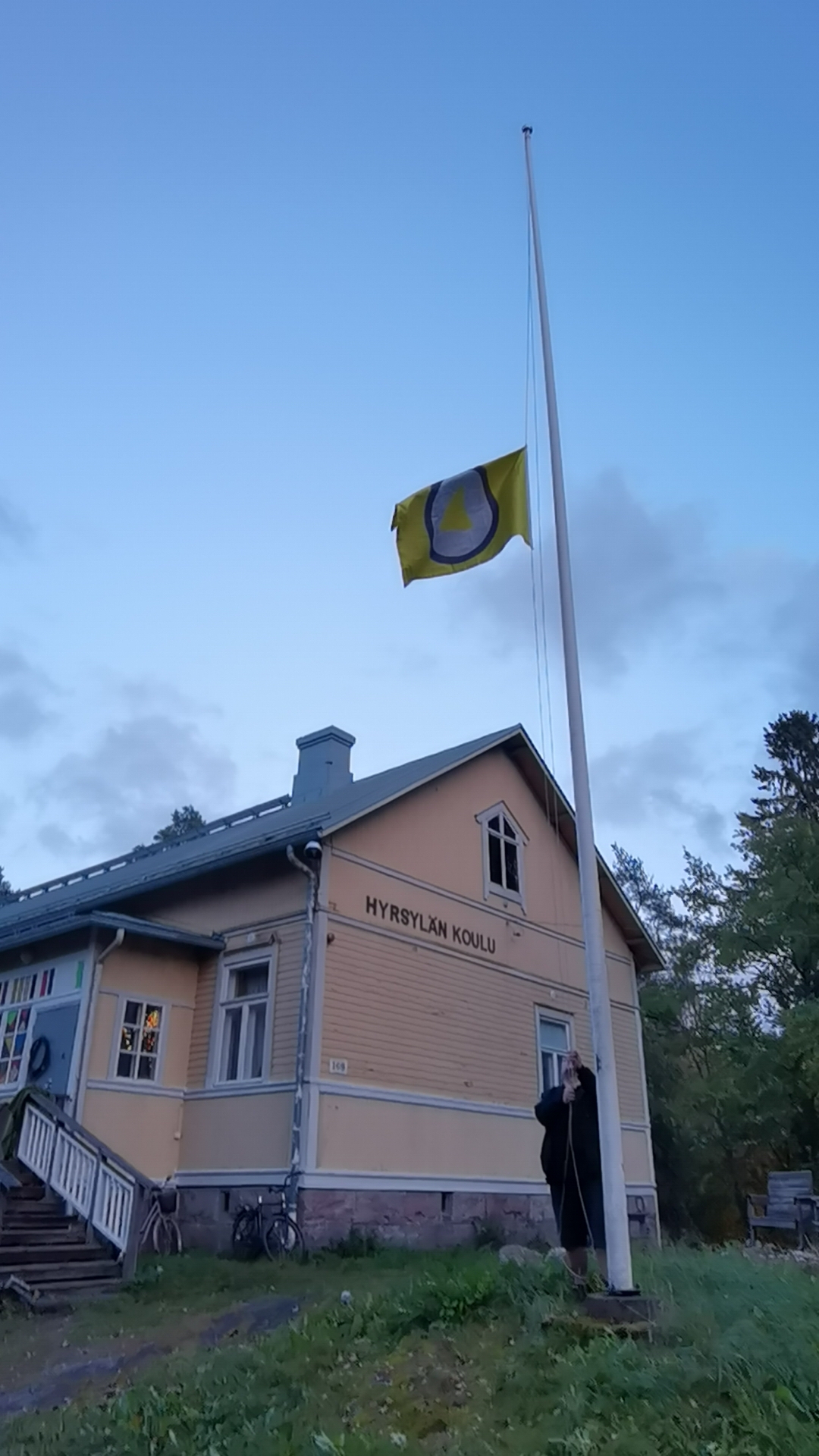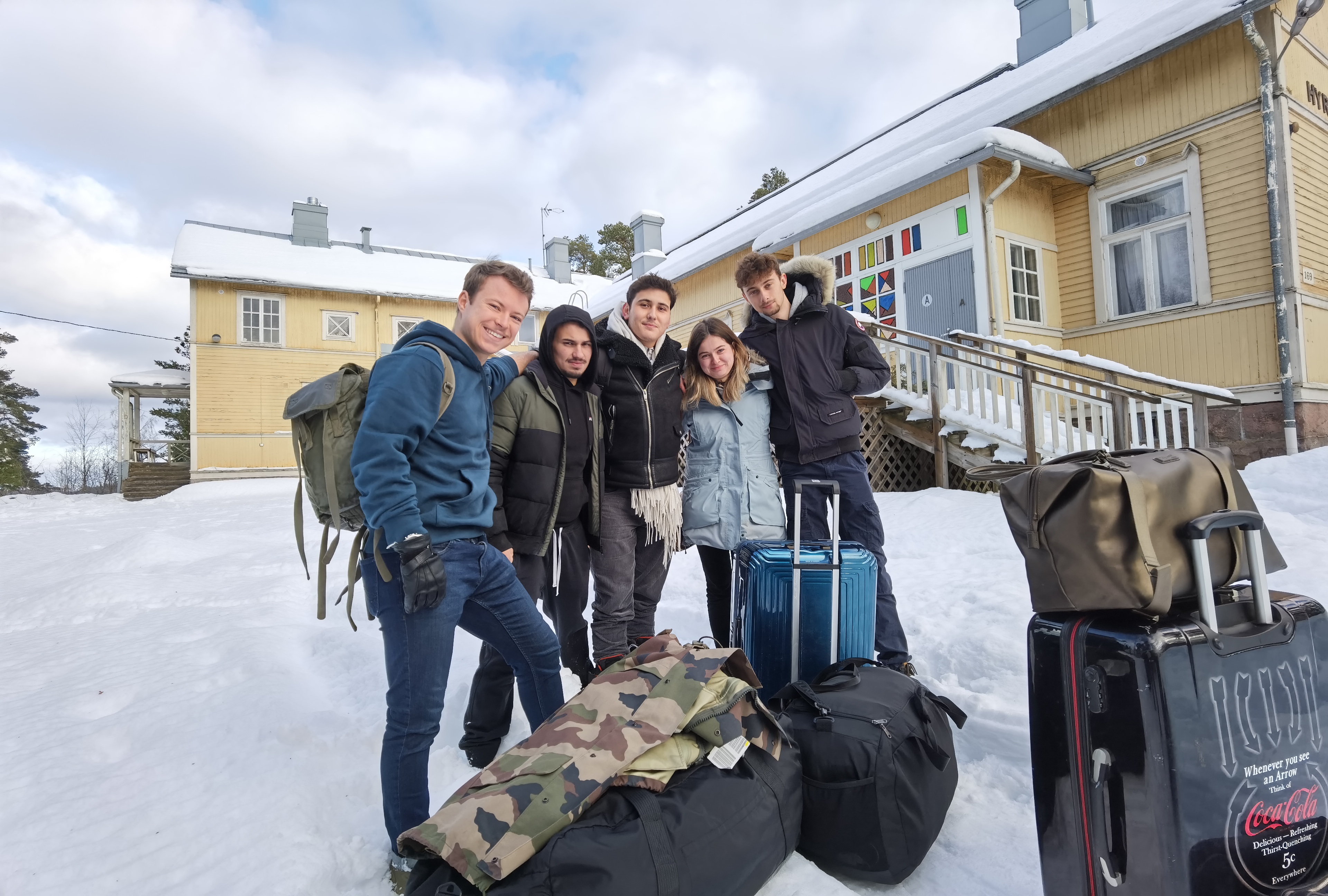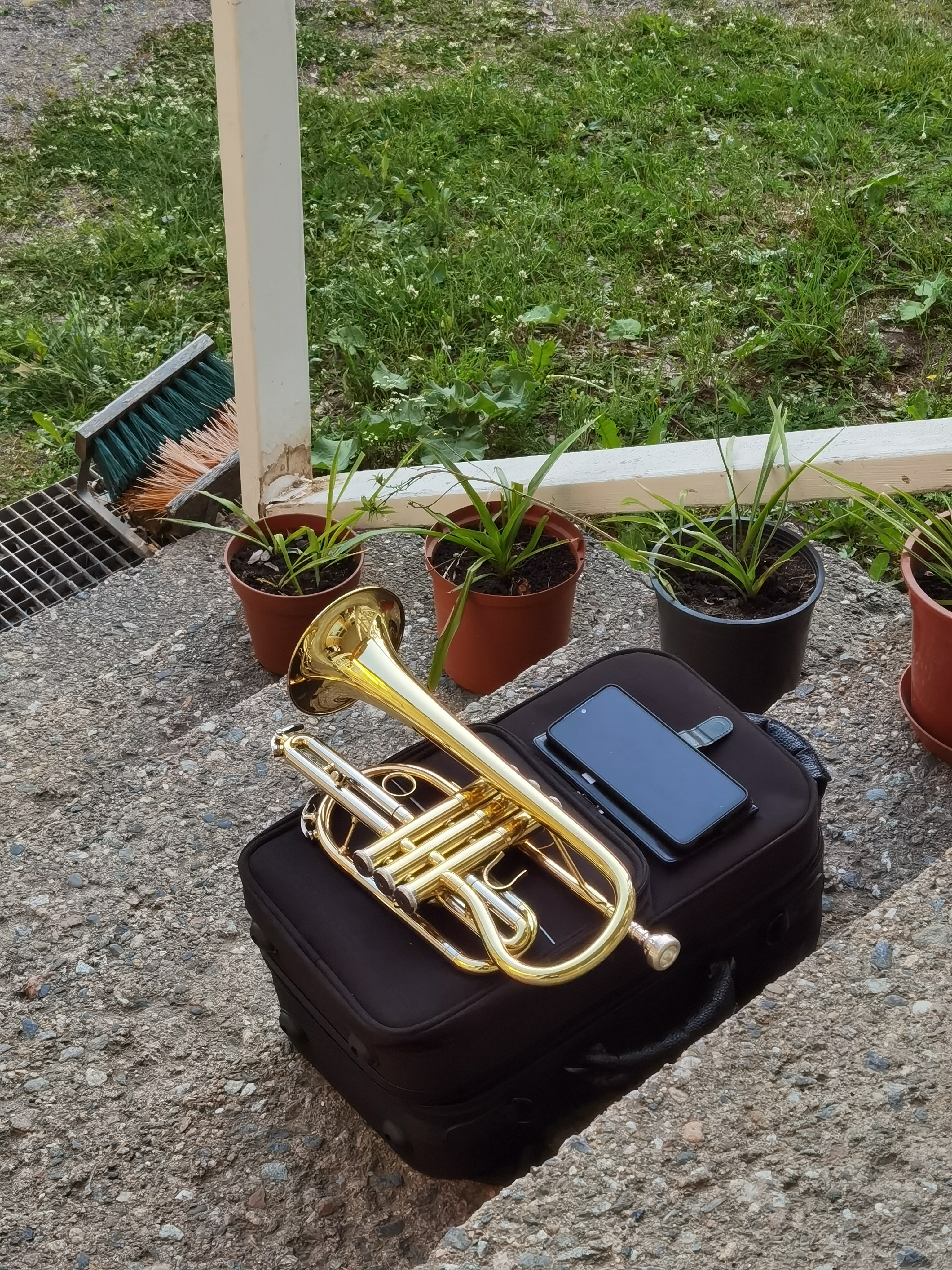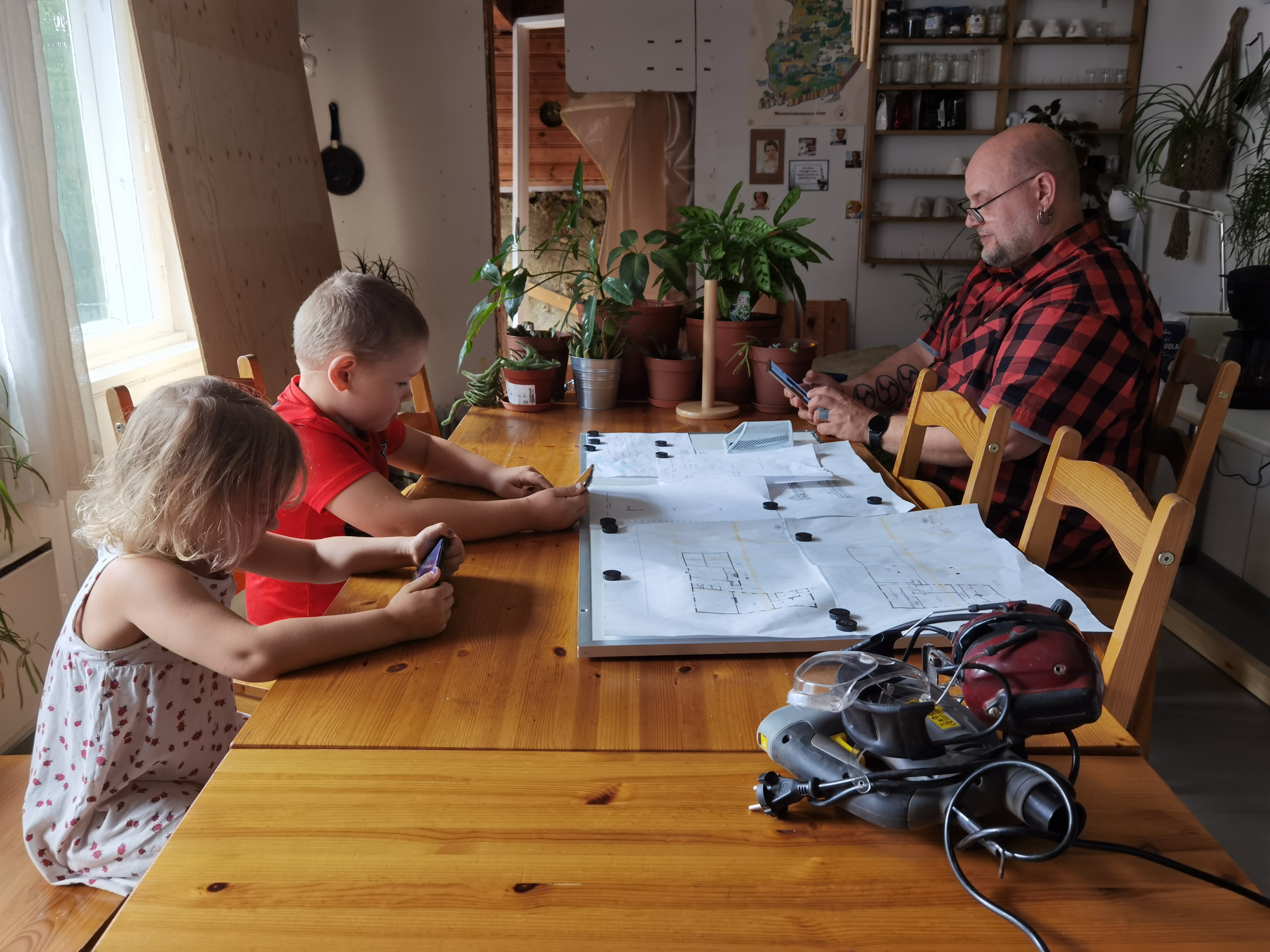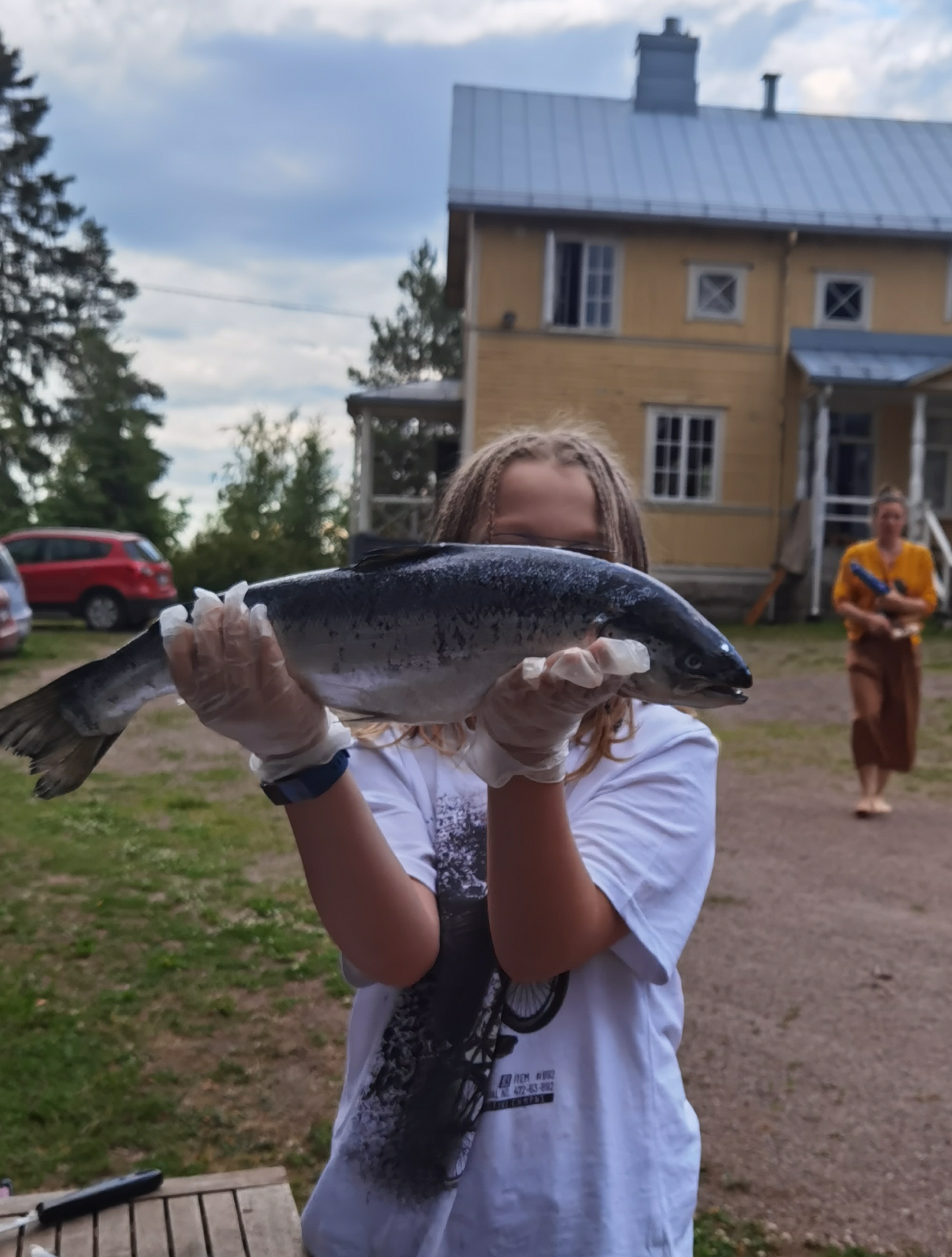Regaining a sense of belonging
Gamified Cohousing
We renovate abandoned buildings into cohousing and coworking economies
Gamified Cohousing brings life back to abandoned properties across Finland and Europe, transforming them into vibrant spaces that serve as both homes and workplaces. By infusing these spaces with cultural experiences, we offer residents and visitors an opportunity to immerse themselves in local traditions and artistry. The result is a fusion of community living, coworking and cultural tourism, designed to drive sustainable urban development while celebrating regional heritage.
Finland
National
It addresses urban-rural linkages
It refers to a physical transformation of the built environment (hard investment)
Yes
2025-01-14
No
No
Yes
Yes
Yes
As a representative of an organisation
The Gamified Cohousing project, active in five Finnish cities and currently expanding to Portugal, transforms abandoned buildings into economies. By mixing private spaces with shared areas and managing it with a gaming app, it revitalizes neglected urban spaces while fostering cooperation. Residents contribute to communal tasks through a game-based system that tracks participation, allowing them to earn points and lower their living costs.
This project goes beyond architecture—it's a social experiment testing urban development, community building, and behavioural economics, exploring how people shape their environment when given agency.
Target Group(s):
- Individuals seeking affordable, community-oriented housing.
- People interested in cooperative living models with shared responsibilities.
- Those experiencing social isolation, benefiting from structured interaction.
- Sustainability advocates promoting resource-sharing and urban renewal.
Specific Objectives:
- Revitalize Abandoned Spaces – Transform vacant buildings into self-sustaining housing communities.
- Encourage Engagement – Reward residents for communal contributions via a gamified system.
- Balance Private & Shared Spaces – Foster social bonds while respecting individual needs.
- Enhance Sustainability – Reduce urban waste by repurposing infrastructure and renovate stuff at home!
- Make Housing Affordable – Offer a dynamic model where participation lowers costs.
Achieved Outcomes
- Expansion Across Five Cities – The model has proven scalable, breathing new life into multiple abandoned buildings.
- The gaming app is published
- Sustained shared living spaces - People are actually paying less for living!
- Increased Participation & Belonging – Residents actively shape and maintain their communities.
- Repurpose of vacant buildings - we recovered over 5k m2 of abandoned heritage houses
This project goes beyond architecture—it's a social experiment testing urban development, community building, and behavioural economics, exploring how people shape their environment when given agency.
Target Group(s):
- Individuals seeking affordable, community-oriented housing.
- People interested in cooperative living models with shared responsibilities.
- Those experiencing social isolation, benefiting from structured interaction.
- Sustainability advocates promoting resource-sharing and urban renewal.
Specific Objectives:
- Revitalize Abandoned Spaces – Transform vacant buildings into self-sustaining housing communities.
- Encourage Engagement – Reward residents for communal contributions via a gamified system.
- Balance Private & Shared Spaces – Foster social bonds while respecting individual needs.
- Enhance Sustainability – Reduce urban waste by repurposing infrastructure and renovate stuff at home!
- Make Housing Affordable – Offer a dynamic model where participation lowers costs.
Achieved Outcomes
- Expansion Across Five Cities – The model has proven scalable, breathing new life into multiple abandoned buildings.
- The gaming app is published
- Sustained shared living spaces - People are actually paying less for living!
- Increased Participation & Belonging – Residents actively shape and maintain their communities.
- Repurpose of vacant buildings - we recovered over 5k m2 of abandoned heritage houses
Community
Gamification
Renovation
Cohousing
Self-Governance
Gamified Cohousing addresses sustainability technically & socially: by transforming abandoned buildings into self-sustaining communities. Through a 5-step method, in a mix of minimal spatial repurposing, shared economies, and behavioral incentives, the project demonstrates an innovative approach to sustainable living.
Key Sustainability Objectives & Achievements
1. Reactivating Abandoned Spaces:
Objective: Reduce vacancies by repurposing empty buildings instead of constructing new ones
Achievement: Successfully transformed 5 neglected properties (4 abandoned schools and 1 train station) into functional housing in 5 cities, reducing decay and land-use pressure.
2. Resource Efficiency & Shared Infrastructure
Objective: Optimize space, energy, and material use by promoting shared facilities.
Achievement: Residents share kitchens, event halls, dormitories, and utilities, significantly lowering per capita resource consumption.
3. Behavioral Incentives for Sustainable Living
Objective: Encourage eco-friendly habits through gamification.
Achievement: A point-based system rewards sustainable actions (e.g., energy-saving, waste reduction, communal work), leading to a more responsible lifestyle.
4. Affordable & Inclusive Housing Model
Objective: Make housing more accessible while maintaining economic sustainability.
Achievement: By earning points through communal contributions, residents lower their living costs, creating a self-sustaining micro-economy.
5. Scalability & Replicability
Objective: Develop a model adaptable to other cities and contexts.
Achievement: The project’s success demonstrates how gamified cohousing can be scaled, making it an exemplary model for sustainable regeneration.
Gamified Cohousing stands out as an innovative and scalable solution to sustainability challenges. By integrating social, economic, and environmental sustainability, it serves as a blueprint for future cohousing initiatives worldwide.
Key Sustainability Objectives & Achievements
1. Reactivating Abandoned Spaces:
Objective: Reduce vacancies by repurposing empty buildings instead of constructing new ones
Achievement: Successfully transformed 5 neglected properties (4 abandoned schools and 1 train station) into functional housing in 5 cities, reducing decay and land-use pressure.
2. Resource Efficiency & Shared Infrastructure
Objective: Optimize space, energy, and material use by promoting shared facilities.
Achievement: Residents share kitchens, event halls, dormitories, and utilities, significantly lowering per capita resource consumption.
3. Behavioral Incentives for Sustainable Living
Objective: Encourage eco-friendly habits through gamification.
Achievement: A point-based system rewards sustainable actions (e.g., energy-saving, waste reduction, communal work), leading to a more responsible lifestyle.
4. Affordable & Inclusive Housing Model
Objective: Make housing more accessible while maintaining economic sustainability.
Achievement: By earning points through communal contributions, residents lower their living costs, creating a self-sustaining micro-economy.
5. Scalability & Replicability
Objective: Develop a model adaptable to other cities and contexts.
Achievement: The project’s success demonstrates how gamified cohousing can be scaled, making it an exemplary model for sustainable regeneration.
Gamified Cohousing stands out as an innovative and scalable solution to sustainability challenges. By integrating social, economic, and environmental sustainability, it serves as a blueprint for future cohousing initiatives worldwide.
There is no other project out there like gamified Cohousing in integrating aesthetics and effective communal life experience: for example, in Oulu, we integrated the 1st worldwide Air Guitar School into the Gamified Cohousing shared spaces. Using art and culture to enhance the shared spaces activities.
Key Objectives & Achievements
1. Transforming Neglected Spaces
a. Objective: Repurpose abandoned buildings into functional, aesthetically appealing homes.
b. Achievement: Interiors are redesigned with minimal intervention, natural light, flexible and modular layouts, and inviting communal areas such as event halls, workshop rooms and saunas.
2. Celebrating Local Culture & Identity
a. Objective: Integrate cultural elements to foster a strong sense of place.
b. Achievement: The Oulu cohousing features the world’s first permanent Air Guitar installation, celebrating the city’s musical heritage, while the Gamified Cohousing Hyrsylän Koulu, a former school, hosts regular events with the local population, the cultural saunas, documenting its history and preserving its cultural legacy.
3. Fostering Social & Artistic Engagement
a. Objective: Create dynamic spaces for cultural and artistic exchange.
b. Achievement: Shared spaces host performances, workshops, and storytelling sessions, transforming them into cultural hubs.
4. Balancing Private & Shared Spaces
a. Objective: Ensure comfort while promoting interaction.
b. Achievement: Private rooms coexist with lively shared areas, allowing both privacy and community engagement.
5. Encouraging Play & Creativity
a. Objective: Use gamification and artistic elements to enhance daily life.
b. Achievement: The Air Guitar School and other projects invite spontaneous interaction, making the space more engaging and unique.
By integrating design, history, and interactive experiences, the project blends art, culture, and community-building, setting a new standard for socially vibrant and meaningful regeneration.
Key Objectives & Achievements
1. Transforming Neglected Spaces
a. Objective: Repurpose abandoned buildings into functional, aesthetically appealing homes.
b. Achievement: Interiors are redesigned with minimal intervention, natural light, flexible and modular layouts, and inviting communal areas such as event halls, workshop rooms and saunas.
2. Celebrating Local Culture & Identity
a. Objective: Integrate cultural elements to foster a strong sense of place.
b. Achievement: The Oulu cohousing features the world’s first permanent Air Guitar installation, celebrating the city’s musical heritage, while the Gamified Cohousing Hyrsylän Koulu, a former school, hosts regular events with the local population, the cultural saunas, documenting its history and preserving its cultural legacy.
3. Fostering Social & Artistic Engagement
a. Objective: Create dynamic spaces for cultural and artistic exchange.
b. Achievement: Shared spaces host performances, workshops, and storytelling sessions, transforming them into cultural hubs.
4. Balancing Private & Shared Spaces
a. Objective: Ensure comfort while promoting interaction.
b. Achievement: Private rooms coexist with lively shared areas, allowing both privacy and community engagement.
5. Encouraging Play & Creativity
a. Objective: Use gamification and artistic elements to enhance daily life.
b. Achievement: The Air Guitar School and other projects invite spontaneous interaction, making the space more engaging and unique.
By integrating design, history, and interactive experiences, the project blends art, culture, and community-building, setting a new standard for socially vibrant and meaningful regeneration.
The core of Gamified Cohousing is to be exactly that: inclusive, accessible, and affordable, by fostering a diverse community where everyone can actively shape their living environment. Through shared governance, adaptive design, and a gamified economic model, it promotes equal access to housing and a strong sense of belonging.
Key Objectives & Achievements
1. Affordable & Accessible Housing
o Objective: Reduce financial barriers and make co-living accessible to all.
o Achievement: Residents earn points by contributing to communal tasks and shaping their own built environment, lowering their living costs and ensuring affordability regardless of income level.
2. Inclusive Governance & Participation
o Objective: Empower residents to co-manage their housing collectively.
o Achievement: Decision-making is participatory, with a governance model that allows all members to shape rules, responsibilities, create tasks in the app and even the physical space through a reward-based system.
3. Social Inclusion & Community Building
o Objective: Create a supportive environment that reduces social isolation and fosters connection.
Achievement: Shared spaces and cultural initiatives, such as Hyrsylän Koulu’s historical events and Oulu’s Air Guitar installation, encourage engagement across different age groups and backgrounds.
4. New Societal Models for Living
o Objective: Rethink traditional housing through cooperative living and resource-sharing.
o Achievement: The project blends private and shared spaces with a self-sustaining 5-step economic model, proving that collective living can be both inclusive and sustainable.
Gamified Cohousing Project sets a new benchmark for inclusive living, demonstrating how gaming and service architecture can create resilient and equitable housing models for the future.
Key Objectives & Achievements
1. Affordable & Accessible Housing
o Objective: Reduce financial barriers and make co-living accessible to all.
o Achievement: Residents earn points by contributing to communal tasks and shaping their own built environment, lowering their living costs and ensuring affordability regardless of income level.
2. Inclusive Governance & Participation
o Objective: Empower residents to co-manage their housing collectively.
o Achievement: Decision-making is participatory, with a governance model that allows all members to shape rules, responsibilities, create tasks in the app and even the physical space through a reward-based system.
3. Social Inclusion & Community Building
o Objective: Create a supportive environment that reduces social isolation and fosters connection.
Achievement: Shared spaces and cultural initiatives, such as Hyrsylän Koulu’s historical events and Oulu’s Air Guitar installation, encourage engagement across different age groups and backgrounds.
4. New Societal Models for Living
o Objective: Rethink traditional housing through cooperative living and resource-sharing.
o Achievement: The project blends private and shared spaces with a self-sustaining 5-step economic model, proving that collective living can be both inclusive and sustainable.
Gamified Cohousing Project sets a new benchmark for inclusive living, demonstrating how gaming and service architecture can create resilient and equitable housing models for the future.
The Gamified Cohousing Project is a citizen-driven initiative where residents and civil society shape both the built environment and governance model. Their active participation ensures the project remains inclusive, adaptable, and socially sustainable.
Citizen Participation & Impact
Residents as Co-Creators
Residents shape their living spaces through a gamified system, earning points by performing communal tasks and improving infrastructure.
This fosters ownership, social responsibility, and adaptability, making the project self-sustaining.
Community Decision-Making
Residents engage in participatory governance, deciding on rules, resource allocation, and communal activities.
This democratic model strengthens engagement and belonging, as seen in Hyrsylän Koulu, where historical events are organized collectively.
Civil Society & Cultural Integration
Local groups, artists, and organizations contribute through events, workshops, and artistic residencies, such as Taikabox at the Oulu cohousing.
These collaborations enhance cultural identity, attract wider community involvement, and foster social connections.
Urban Regeneration & Social Impact
The project works with municipalities, businesses, and advocacy groups to revitalize abandoned buildings.
This creates economic opportunities and serves as a model for sustainable urban development.
Why This Project Is Exemplary
Empowers residents to actively shape their environment.
Promotes democratic governance, ensuring fairness and adaptability.
Strengthens cultural and social ties through civil society engagement.
Scales and inspires other cities to adopt similar participatory models.
By integrating citizens into decision-making, design, and daily operations, Gamified Cohousing redefines urban living, proving that people can actively shape and sustain their own communities.
Citizen Participation & Impact
Residents as Co-Creators
Residents shape their living spaces through a gamified system, earning points by performing communal tasks and improving infrastructure.
This fosters ownership, social responsibility, and adaptability, making the project self-sustaining.
Community Decision-Making
Residents engage in participatory governance, deciding on rules, resource allocation, and communal activities.
This democratic model strengthens engagement and belonging, as seen in Hyrsylän Koulu, where historical events are organized collectively.
Civil Society & Cultural Integration
Local groups, artists, and organizations contribute through events, workshops, and artistic residencies, such as Taikabox at the Oulu cohousing.
These collaborations enhance cultural identity, attract wider community involvement, and foster social connections.
Urban Regeneration & Social Impact
The project works with municipalities, businesses, and advocacy groups to revitalize abandoned buildings.
This creates economic opportunities and serves as a model for sustainable urban development.
Why This Project Is Exemplary
Empowers residents to actively shape their environment.
Promotes democratic governance, ensuring fairness and adaptability.
Strengthens cultural and social ties through civil society engagement.
Scales and inspires other cities to adopt similar participatory models.
By integrating citizens into decision-making, design, and daily operations, Gamified Cohousing redefines urban living, proving that people can actively shape and sustain their own communities.
Gamified Cohousing emerged from the research of Architectural Democracy from Aalto & Sydney University. It then matured as a business concept at the Mutiny Startup Acceleration Program in 2018, with national and international coaches. Since then, it has engaged local, regional, national, and European stakeholders and events, ensuring a scalable and sustainable model.
Stakeholder Roles & Involvement
1. Local Level: Residents & Municipalities
o Residents co-create and manage spaces through the gamified system, earning points for communal contributions and through the shared activities promoted in the shared spaces
2. Regional Level: Businesses & Housing Cooperatives
o Municipalities and regional companies support our adaptive reuse of abandoned buildings with technical support and via events, for example with the political campaign events of Lohja in 2021 held in our cohousing
3. National Level: Policy Makers & Research Institutions
o Policy makers explore integrating gamified cohousing into national housing policies via debates and discussions done with the Museum of Architecture of Helsinki in 2024
4. European & International Level
o We exhibited our work at the 2021 Venice Biennale of Architecture, and we were showcased on the front cover of several design magazines, and in Helsingin Sanomat, Finland’s largest newspaper.
o We were Invited to China’s Comb+ startup program for discussions, in Shanghai and at the United World College, and Tongji University to present this work as lectures.
o We gave a keynote speech on this the EUbilt in Riga in 2023, at a TEDx event in Portugal, and various others conferences and exhibitions.
By engaging stakeholders at all levels, Gamified Cohousing:
• Empowers local communities while ensuring policy alignment.
• Attracts funding and research, enhancing scalability.
• Gains global recognition, proving its innovation and impact in urban living.
Stakeholder Roles & Involvement
1. Local Level: Residents & Municipalities
o Residents co-create and manage spaces through the gamified system, earning points for communal contributions and through the shared activities promoted in the shared spaces
2. Regional Level: Businesses & Housing Cooperatives
o Municipalities and regional companies support our adaptive reuse of abandoned buildings with technical support and via events, for example with the political campaign events of Lohja in 2021 held in our cohousing
3. National Level: Policy Makers & Research Institutions
o Policy makers explore integrating gamified cohousing into national housing policies via debates and discussions done with the Museum of Architecture of Helsinki in 2024
4. European & International Level
o We exhibited our work at the 2021 Venice Biennale of Architecture, and we were showcased on the front cover of several design magazines, and in Helsingin Sanomat, Finland’s largest newspaper.
o We were Invited to China’s Comb+ startup program for discussions, in Shanghai and at the United World College, and Tongji University to present this work as lectures.
o We gave a keynote speech on this the EUbilt in Riga in 2023, at a TEDx event in Portugal, and various others conferences and exhibitions.
By engaging stakeholders at all levels, Gamified Cohousing:
• Empowers local communities while ensuring policy alignment.
• Attracts funding and research, enhancing scalability.
• Gains global recognition, proving its innovation and impact in urban living.
Architects worked closely with game designers and economists to ensure that the space was both functional and incentivized. Sociologists collaborated with environmental experts to ensure that the community is not only socially sustainable but also eco-friendly.
1. Urban Planning & Architecture
o Our architects designed functional, adaptable spaces that blend private and communal areas, promoting sustainability and accessibility. When needed, we hired local teams to submit the plans locally, such as in Oulu.
o Contribution: we have transformed abandoned buildings into efficient, welcoming communities
2. Behavioural Economics & Game Design
o Experts in behavioural economics and game design developed the app, which incentivizes residents to perform communal tasks and engage in shared governance. We were granted a financial support from Business Finland to make the 1st MVP, with the company Zaibatsu Interactive Oy. Then this work was continued with a master program with the Metropolia University. The last stage of the app has been done by the company Curves & Colours.
o Contribution: The game fosters active participation and responsibility, creating a self-sustaining and fair economy within the cohousing.
3. Environmental Science & Sustainability
o We hold monthly podcasts at the Helsinki Open Waves, and we talk with different experts, such as Matti Kuittinen, a professor on sustainable architecture or Mona Schalin, a highly awarded architect on renovations.
o Contribution: ensured the project is environmentally sustainable, using green technologies and promoting resource-sharing among residents.
4. Cultural & Artistic Contributions
o Artists and cultural groups collaborations, such as with Taikabox and the Factum Foundation, integrated cultural events, art installations, and community workshops.
o Contribution: it enriched the project’s cultural identity and helped build social connections beyond the residential community.
1. Urban Planning & Architecture
o Our architects designed functional, adaptable spaces that blend private and communal areas, promoting sustainability and accessibility. When needed, we hired local teams to submit the plans locally, such as in Oulu.
o Contribution: we have transformed abandoned buildings into efficient, welcoming communities
2. Behavioural Economics & Game Design
o Experts in behavioural economics and game design developed the app, which incentivizes residents to perform communal tasks and engage in shared governance. We were granted a financial support from Business Finland to make the 1st MVP, with the company Zaibatsu Interactive Oy. Then this work was continued with a master program with the Metropolia University. The last stage of the app has been done by the company Curves & Colours.
o Contribution: The game fosters active participation and responsibility, creating a self-sustaining and fair economy within the cohousing.
3. Environmental Science & Sustainability
o We hold monthly podcasts at the Helsinki Open Waves, and we talk with different experts, such as Matti Kuittinen, a professor on sustainable architecture or Mona Schalin, a highly awarded architect on renovations.
o Contribution: ensured the project is environmentally sustainable, using green technologies and promoting resource-sharing among residents.
4. Cultural & Artistic Contributions
o Artists and cultural groups collaborations, such as with Taikabox and the Factum Foundation, integrated cultural events, art installations, and community workshops.
o Contribution: it enriched the project’s cultural identity and helped build social connections beyond the residential community.
The Gamified Cohousing Project stands out for its innovative approach blending game mechanics, participatory governance, and renovations of abandoned building, in ways that mainstream housing practices do not:
1. Gamification of Community Engagement
In contrast to conventional housing models, where residents are passive tenants, Gamified Cohousing integrates game design principles to incentivize active participation. This game-based model reduces living costs and creates a self-sustaining community This approach is unique compared to the passive relationship that typically exists in mainstream housing.
2. Mixed-Use Spaces and Adaptive Reuse of Abandoned Buildings
While mainstream housing projects focus on new developments or traditional rentals, Gamified Cohousing reimagines the use of abandoned or underutilized buildings, converting them into dynamic living environments. Traditional housing practices often prioritize new constructions.
3. Participatory Governance and Decision-Making
Unlike standard housing projects with top-down management, Gamified Cohousing empowers residents through participatory governance. Decisions are made collectively, from setting the rules to organizing events and managing resources.
4. Integration of Behavioral Economics and Sustainability
Mainstream housing rarely incorporates behavioural economics to shape community dynamics. We use economic incentives in the app to align individual actions with collective well-being. Eg. eco-friendly practices such as resource-sharing and energy-saving initiatives, which are encouraged through the gamified system.
5. Cultural and Artistic Integration
Many conventional housing developments overlook the potential of cultural enrichment. Gamified Cohousing integrates artistic and cultural initiatives (e.g., collaborations with Taikabox, World Music School, Factum Foundation, etc), fostering community identity and social cohesion.
1. Gamification of Community Engagement
In contrast to conventional housing models, where residents are passive tenants, Gamified Cohousing integrates game design principles to incentivize active participation. This game-based model reduces living costs and creates a self-sustaining community This approach is unique compared to the passive relationship that typically exists in mainstream housing.
2. Mixed-Use Spaces and Adaptive Reuse of Abandoned Buildings
While mainstream housing projects focus on new developments or traditional rentals, Gamified Cohousing reimagines the use of abandoned or underutilized buildings, converting them into dynamic living environments. Traditional housing practices often prioritize new constructions.
3. Participatory Governance and Decision-Making
Unlike standard housing projects with top-down management, Gamified Cohousing empowers residents through participatory governance. Decisions are made collectively, from setting the rules to organizing events and managing resources.
4. Integration of Behavioral Economics and Sustainability
Mainstream housing rarely incorporates behavioural economics to shape community dynamics. We use economic incentives in the app to align individual actions with collective well-being. Eg. eco-friendly practices such as resource-sharing and energy-saving initiatives, which are encouraged through the gamified system.
5. Cultural and Artistic Integration
Many conventional housing developments overlook the potential of cultural enrichment. Gamified Cohousing integrates artistic and cultural initiatives (e.g., collaborations with Taikabox, World Music School, Factum Foundation, etc), fostering community identity and social cohesion.
We employ an interdisciplinary, user-driven, and experimental approach that integrates game mechanics, participatory governance, and adaptive reuse of buildings. This methodology sets it apart from traditional housing projects, which often rely on static, top-down approaches with little resident involvement.
1. Gamification as a Governance and Design Tool
• The game-based system manages communal living and the future steps of the cohousing. This method, rooted in behavioural economics, motivates participation and self-regulation, replacing traditional hierarchical management models.
2. Participatory and Decentralized Decision-Making
• Residents co-create the rules of the community, shaping their environment based on democratic, collective decision-making. This model empowers individuals, giving them control over shared resources, tasks, and governance, rather than relying on an external property manager or centralized authority.
3. Adaptive Reuse of Abandoned Spaces
• Instead of building new structures, the project revitalizes abandoned or underused buildings, reducing urban waste and preserving architectural heritage. Spaces are redesigned for mixed-use, balancing private and shared areas to foster community interaction. This approach contrasts with mainstream urban development, which prioritizes new construction over sustainability and rehabilitation and sees shared spaces as burdens and not as long term investments.
4. Interdisciplinary Collaboration
• The project combines expertise from a wide range of fields that have refined the gamified system and ongoing academic collaborations ensure the model is data-driven and adaptable.
5. Cultural and Social Experimentation
• Community-building is reinforced through artistic and cultural programs, including collaborations with dance groups like Taikabox and events such as the Air Guitar School in Oulu.
1. Gamification as a Governance and Design Tool
• The game-based system manages communal living and the future steps of the cohousing. This method, rooted in behavioural economics, motivates participation and self-regulation, replacing traditional hierarchical management models.
2. Participatory and Decentralized Decision-Making
• Residents co-create the rules of the community, shaping their environment based on democratic, collective decision-making. This model empowers individuals, giving them control over shared resources, tasks, and governance, rather than relying on an external property manager or centralized authority.
3. Adaptive Reuse of Abandoned Spaces
• Instead of building new structures, the project revitalizes abandoned or underused buildings, reducing urban waste and preserving architectural heritage. Spaces are redesigned for mixed-use, balancing private and shared areas to foster community interaction. This approach contrasts with mainstream urban development, which prioritizes new construction over sustainability and rehabilitation and sees shared spaces as burdens and not as long term investments.
4. Interdisciplinary Collaboration
• The project combines expertise from a wide range of fields that have refined the gamified system and ongoing academic collaborations ensure the model is data-driven and adaptable.
5. Cultural and Social Experimentation
• Community-building is reinforced through artistic and cultural programs, including collaborations with dance groups like Taikabox and events such as the Air Guitar School in Oulu.
So far Gamified Cohousing is showing high adaptable and replicable model that can be transferred to different locations, beneficiary groups, and urban contexts. Its core principles—gamification, participatory governance, and adaptive reuse of buildings—offer solutions to widespread challenges in affordable housing, social inclusion, and sustainable urban development.
1. Gamification as a Universal Community Management Tool
• The app can be applied across different housing models, including cooperatives, student housing, and refugee shelters. This technology will be deployed soon to other shared living environments and workspaces to improve collaborative engagement and resource-sharing. This is likely to happen in 2025.
2. Participatory Governance Model
• The app can be replicated in any cohousing or cooperative housing project, ensuring fairness, adaptability, and engagement. This model reduces reliance on external property managers, making housing more financially accessible and socially cohesive. This has already been tested in multiple Finnish cities and will be applied in other European and global urban contexts.
3. Adaptive Reuse, the 5-step method
• Our 5-step method is scalable for municipalities, developers, and community-led housing initiatives worldwide. Similar initiatives could revitalize unused schools, factories, or office buildings into self-sustaining, community-driven spaces.
4. Integration of Cultural & Artistic Elements
• The collaborations with artists, cultural organizations, and universities could be adopted in various urban renewal projects to strengthen community identity. We are now organizing a symposium in Oulu with the factum foundation, about renovation.
5. Interdisciplinary & Academic Partnerships
• The project’s collaborations with universities, research institutions, and business accelerators provide a knowledge-sharing framework that could be adapted to other educational and policy-driven initiatives.
1. Gamification as a Universal Community Management Tool
• The app can be applied across different housing models, including cooperatives, student housing, and refugee shelters. This technology will be deployed soon to other shared living environments and workspaces to improve collaborative engagement and resource-sharing. This is likely to happen in 2025.
2. Participatory Governance Model
• The app can be replicated in any cohousing or cooperative housing project, ensuring fairness, adaptability, and engagement. This model reduces reliance on external property managers, making housing more financially accessible and socially cohesive. This has already been tested in multiple Finnish cities and will be applied in other European and global urban contexts.
3. Adaptive Reuse, the 5-step method
• Our 5-step method is scalable for municipalities, developers, and community-led housing initiatives worldwide. Similar initiatives could revitalize unused schools, factories, or office buildings into self-sustaining, community-driven spaces.
4. Integration of Cultural & Artistic Elements
• The collaborations with artists, cultural organizations, and universities could be adopted in various urban renewal projects to strengthen community identity. We are now organizing a symposium in Oulu with the factum foundation, about renovation.
5. Interdisciplinary & Academic Partnerships
• The project’s collaborations with universities, research institutions, and business accelerators provide a knowledge-sharing framework that could be adapted to other educational and policy-driven initiatives.
We tackle pressing global challenges—such as affordable housing, urban loneliness, resource inefficiency, and social inequality —by implementing innovative, community-driven solutions at a local level:
1. Housing Crisis & Affordability
Global Challenge:
• Rapid urbanization has led to housing shortages and skyrocketing rents, making cities unaffordable for many. Traditional property models favour profit-driven development over community needs.
Local Solution:
• Gamified Cohousing transforms abandoned buildings into affordable, functional homes.
• Residents actively reduce their living costs by earning points for completing community tasks.
• The shared economy model optimizes resources, lowering financial burdens without compromising quality.
2. Social Isolation & Loss of Community
Global Challenge:
• Loneliness is rising, affecting mental health and social well-being.
Local Solution:
• The project blends private and communal spaces, encouraging daily social engagement.
• Cultural and artistic collaborations create opportunities for shared experiences.
• The participatory governance model strengthens community ties.
3. Urban Decay & Sustainable Development
Global Challenge:
• Cities suffer from vacant buildings and inefficient land use.
• The construction industry contributes massively to CO₂ emissions and environmental degradation.
Local Solution:
• Gamified Cohousing repurposes abandoned buildings, reducing urban blight and minimizing the environmental footprint.
• Residents are encouraged to adopt eco-friendly behaviours through gamification.
4. Inequality in Decision-Making & Governance
Global Challenge:
• Traditional housing models exclude residents from decision-making
• Gentrification and privatization push vulnerable groups out of their neighbourhoods.
Local Solution:
• Participatory governance allows residents to shape their living spaces, fostering ownership and agency.
• The gamified point system democratizes participation.
1. Housing Crisis & Affordability
Global Challenge:
• Rapid urbanization has led to housing shortages and skyrocketing rents, making cities unaffordable for many. Traditional property models favour profit-driven development over community needs.
Local Solution:
• Gamified Cohousing transforms abandoned buildings into affordable, functional homes.
• Residents actively reduce their living costs by earning points for completing community tasks.
• The shared economy model optimizes resources, lowering financial burdens without compromising quality.
2. Social Isolation & Loss of Community
Global Challenge:
• Loneliness is rising, affecting mental health and social well-being.
Local Solution:
• The project blends private and communal spaces, encouraging daily social engagement.
• Cultural and artistic collaborations create opportunities for shared experiences.
• The participatory governance model strengthens community ties.
3. Urban Decay & Sustainable Development
Global Challenge:
• Cities suffer from vacant buildings and inefficient land use.
• The construction industry contributes massively to CO₂ emissions and environmental degradation.
Local Solution:
• Gamified Cohousing repurposes abandoned buildings, reducing urban blight and minimizing the environmental footprint.
• Residents are encouraged to adopt eco-friendly behaviours through gamification.
4. Inequality in Decision-Making & Governance
Global Challenge:
• Traditional housing models exclude residents from decision-making
• Gentrification and privatization push vulnerable groups out of their neighbourhoods.
Local Solution:
• Participatory governance allows residents to shape their living spaces, fostering ownership and agency.
• The gamified point system democratizes participation.
Gamified Cohousing fosters community, participation, and shared purpose, helping residents and surrounding communities regain a sense of belonging. Through inclusive governance, cultural activities, and gamified engagement, it creates self-sustaining, socially connected environments where people feel invested in their homes and communities.
Key Outcomes & Benefits
1. Strengthened Social Bonds & Community Engagement
- Residents as Co-Creators: Residents actively shape their environment through a gamified point system, fostering ownership and commitment.
- Shared Experiences: Collaborative decision-making, communal tasks, and cultural events (e.g., Hyrsylän Koulu’s historical documentation, Taikabox’s artistic residencies, and the Air Guitar installation in Oulu) build social cohesion.
- Local Community Revival: In Kannus, the renovation of the century-old railway station has reconnected local associations and turned the station into a community hub with a new café in the shared spaces.
2. Affordable & Empowering Living
- Financial Accessibility: The point-based system lowers housing costs by rewarding participation, making urban living more affordable.
- Self-Sufficiency: Residents actively manage and improve their living conditions, creating self-reliant communities.
- Student Integration: In Kajaani, Gamified Cohousing mixes international and Finnish students (50% international), fostering cross-cultural exchange.
- Entrepreneurial Support: In Lappeenranta, the old school serves as a residential and business space, allowing locals to develop small businesses like Karoliina’s well-being clinic.
3. Cultural & Civic Integration
- Intergenerational & Cross-Cultural Exchange: Collaborations with artists, local organizations, and universities bridge diverse social groups and foster inclusivity.
- Recognition & Global Impact: Featured in Venice Biennale 2021, TEDx Portugal, and EU Build Riga, the project has inspired replication in other urban contexts.
Key Outcomes & Benefits
1. Strengthened Social Bonds & Community Engagement
- Residents as Co-Creators: Residents actively shape their environment through a gamified point system, fostering ownership and commitment.
- Shared Experiences: Collaborative decision-making, communal tasks, and cultural events (e.g., Hyrsylän Koulu’s historical documentation, Taikabox’s artistic residencies, and the Air Guitar installation in Oulu) build social cohesion.
- Local Community Revival: In Kannus, the renovation of the century-old railway station has reconnected local associations and turned the station into a community hub with a new café in the shared spaces.
2. Affordable & Empowering Living
- Financial Accessibility: The point-based system lowers housing costs by rewarding participation, making urban living more affordable.
- Self-Sufficiency: Residents actively manage and improve their living conditions, creating self-reliant communities.
- Student Integration: In Kajaani, Gamified Cohousing mixes international and Finnish students (50% international), fostering cross-cultural exchange.
- Entrepreneurial Support: In Lappeenranta, the old school serves as a residential and business space, allowing locals to develop small businesses like Karoliina’s well-being clinic.
3. Cultural & Civic Integration
- Intergenerational & Cross-Cultural Exchange: Collaborations with artists, local organizations, and universities bridge diverse social groups and foster inclusivity.
- Recognition & Global Impact: Featured in Venice Biennale 2021, TEDx Portugal, and EU Build Riga, the project has inspired replication in other urban contexts.

